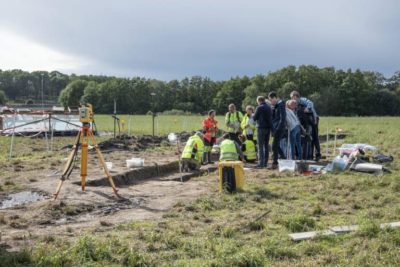Archaeologists and Norway’s director of cultural heritage are calling for rapid excavation of a Viking ship found buried in a field at Gjellestad near Halden in the fall of 2018. They’ve won initial support from government officials, setting the stage for what could be the first full-scale Viking ship excavation in Norway for 114 years.

“A Viking ship is so important for Norwegian history, and we have an international responsibility here,” said Ola Elvestuen, government minister in charge of culture and the environment, just after test results from the site were presented on Friday. They were extracted during careful and preliminary digging around the vessel in August and September of last year.
Samples from the so-called “Gjellestad-ship’s” keel found last year have revealed signs of mildew or dry rot, indicating that the vessel could rapidly deteriorate if left in the ground. The overall condition of the ship was described as poor.
“When it’s no longer an alternative to take care of the vessel by letting it remain in the ground, this is no longer about how much of the ship should be dug out, but about when, how and to what degree it should be done,” Elvestuen added. He fears, along with the experts, that much of the vessel may rot away unless a major excavation gets underway “in the course of quite a short time.”

The vessel’s discovery through the use of georadar made international news in the fall of 2018. It’s believed to have been buried along with a Viking chief referred to in one of the sagas as “King Jell” in the area that’s also believed to contain five Viking langhus (literally, long houses that housed both people and animals) and at least 10 burial mounds. Two of the houses date from the years 400-500 while the ship has been linked to the early Viking period that ran from around 800-1050AD. Archaeologists have dated it to 733AD at the earliest.
Preliminary excavation work has led not only to the dating but to results of other analyses and an evaluation of the ship’s condition. Hanna Geiran, known as Norway’s Riksantikvar in charge of preserving cultural monuments, presented the report by archaeologists and officials from the University of Oslo and its Museum of Cultural History to Elvestuen.

Samples of the ship’s preserved wood have been attacked by dry rot, with indications that the vessel can be deteriorating rapidly. As ground water levels have fallen in the area, oxygen has made its way down to the vessel, allowing mildew to form.
It remains unclear whether a full excavation is possible, but the experts recommend moving quickly to secure knowledge and any potential for putting the vessel on display.
Geiran noted that technology and techniques have come a long way since Norway’s Gokstad and Oseberg Viking ships were excavated more than 100 years ago at Sandefjord and Tønsberg respectively. Her office noted in a press release that it’s “thought-provoking” how samples of the wood from the Gjellestad ship are similar to those of the Oseberg ship and one of the small boats found during the Gokstad excavation.
“We have the potential to find out so much more, and gain so much more knowledge,” Geiran told newspaper Aftenposten. “It can give us results from which we can learn a lot. We can get an entirely new picture of the lives that people lived here.”
Like the Viking burial mound area at Borre just north of Tønsberg, where the outlines of yet another Viking ship were found last year, Gjellestad is part of an ancient landscape that once featured “monumental burial mounds and large buildings,” according to Riksantikvaren. It added that there are “strong indications” that Gjellestad, like Gokstad, was once a major trading site and home to powerful people of the Viking age.
It’s believed the vessel was built in either western- or southwestern Norway and sailed to the site where it was eventually buried. The field at Gjellestad now lies close to the busy E6 motorway, northwest of Halden and around an hour’s drive south of Oslo.
newsinenglish.no/Nina Berglund

